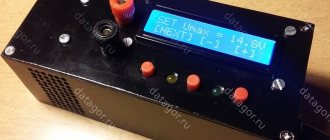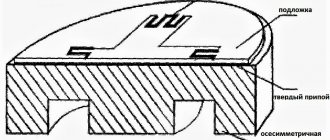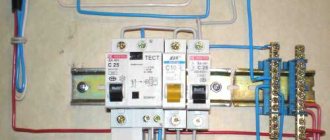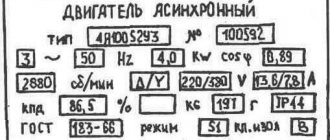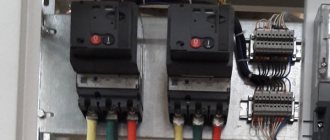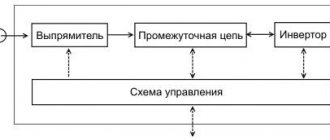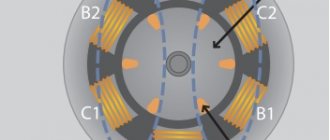Protection against electric shock using a differential circuit breaker
Modern society is characterized by the widespread use of a variety of electrical equipment.
There are often cases when newly purchased equipment is connected to wiring that is not designed for high current consumption. Another situation: instead of expensive devices from well-known manufacturers, in order to save money, designs from little-known brands are purchased. Unscrupulous manufacturers reduce the cost of products to the detriment of quality. In order to increase human safety and prevent fires, a variety of protection devices have been developed.
Additional recommendations
- Pay attention to the “Test” button, with which you can test such a protective device for correct operation.
- It is not always necessary to install a differential circuit breaker into the electrical network of a house or apartment. And if the installation is already done. It is better to carry out installation on socket groups. Lighting, as well as the circuit that powers the electric hob, are not equipped with this device.
- The PUE rules state that difavtomats must be installed in networks where there is a “PE” grounding loop.
Pay special attention not only to the choice of differential machine, but also to its proper installation. This is what most often determines how the entire electrical network will work and how safe it will be. Therefore, the assembly of the switchboard should be carried out by a professional electrician. Although it is not difficult to carry out this process yourself.
What is a differential automatic and what is it for?
The differential circuit breaker structurally combines two types of protection in a single housing:
- From overload (short circuit, exceeding the permissible value of current consumption);
- From leakage currents.
The first type is used in automatic circuit breakers and provides for disconnecting the phase and neutral conductors when the load current increases above that for which the circuit breaker is designed. The second type of protection is used in RCDs - residual current devices. The principle of operation is to compare the currents in the neutral and phase wires. The presence of a difference indicates the appearance of a leakage current, which can be dangerous.
In fact, the difavtomat combines two devices in one housing.
Advantages and disadvantages
The difavtomat has the following advantages:
- Saving space in distribution boards due to the combination of two devices.
- Simplify installation and reduce the number of wire connection points.
- If triggered, all supply conductors (zero and phase) are opened simultaneously.
At the same time, these devices also have disadvantages:
- Higher cost.
- Difficulty in diagnosing the cause of the trigger.
- When damaged, it changes completely, regardless of what type of protection has failed.
Thus, if with separately installed circuit breakers and RCDs it is possible to easily determine what caused the operation (short circuit or leakage current) and, if necessary, replace the necessary device, then the differential circuit breaker is changed entirely. Moreover, some skills are required to find the reasons.
Application area
The difavtomat, like the RCD, best reveals its advantages when installed in circuits that require special control.
This is a powerful load, located in rooms with high danger, the presence of equipment sensitive to the parameters of the power supply network. Dangerous areas include those with high humidity and the presence of electrical equipment. For example, a bathroom with an electric boiler or washing machine, a kitchen with an electric stove.
Rated breaking capacity
Based on the shutdown rating, difavtomats, as well as automatic switches, are divided into several types. On the body of the device in a rectangle there is a number 3000, 4500, 6000 or 10000. It indicates what short-circuit current in amperes the difavtomat will withstand without disruption during further use.
Devices with maximum value are used in production facilities and workshops. Devices rated at 6000 A are typically used in buildings with new electrical wiring that can withstand high currents for short periods of time.
In rural areas, devices with a value of 4500 A are usually used, where the wiring is worse and the power supply lines are weaker.
Where is it better to install a difavtomat instead of an RCD?
Considering that a differential circuit breaker takes up less space than jointly installed current circuit breakers and RCDs, they are most convenient when placed in small-sized distribution boards. It is also convenient to use difavtomats in panels that distribute power to a large number of circuits, since this can significantly simplify the load. At the same time, reliability increases, since the weak points in distribution boards are the switching points - the terminals of devices with connected wires.
Safety is important
When designing and installing a low-voltage electrical network, one of the main tasks for specialists is protection against short circuits and ensuring the maximum level of safety.
To solve this problem, special devices are used, one of which is a differential automatic machine (difavtomat).
Below we will consider the following questions:
- What is this product?
- What are they used for, and what types of automatic machines are there?
- What elements does it consist of, and how does it work?
- How to decipher the symbols and connect the difavtomat?
- What are the reasons for the triggering?
Options
When installing a difavtomat, three main parameters should be taken into account:
- Supply voltage and number of phases – 220V or 380V, 1 phase or 3.
- Operation current. This parameter is similar to that of the circuit breaker.
- Leakage current. Everything here is similar to an RCD.
There are a few more parameters that not everyone is familiar with:
- Rated breaking capacity. Short circuit current that the device can withstand without malfunctioning.
- Response time of differential protection.
- Current limiting class. Shows the time it takes to extinguish the electric arc during a short circuit.
- The type of electromagnetic release on which the excess of the operating current compared to the rated one depends.
Type of electromagnetic release
The electromagnetic release in the automatic circuit breaker is designed to instantly open the circuit when the rated current is exceeded by a specified number of times. The following types are common:
- B – the operating current exceeds the rated current by 3-5 times.
- C – operation current exceeds the rated current by 5-10 times.
- D – operation current exceeds the rated current by 10-20 times.
Leakage current (disconnecting differential current) and its class
The sensitivity threshold of the differential transformer determines the leakage current, which triggers the protection. The most widespread are differential transformers with a sensitivity of 10 and 30 mA.
In addition to the numerical value of the leakage current, the shape is important. In accordance with this, the following classes of protection devices are distinguished:
- AC – sinusoidal leakage current is controlled.
- A - in addition to sinusoidal, a pulsating constant is taken into account, which is important when protecting digital electronic equipment.
- B – a smoothed constant is added to the listed currents.
- S – shutdown time delay – 200-300 ms.
- G – time delay – 60-80 ms.
Rated breaking capacity and current limiting class
This parameter characterizes the short circuit current that the contact group of the circuit breaker is able to withstand without damage during the shutdown time. The higher the value of the parameter, the greater the likelihood that after eliminating the damage in the network, the difavtomat will remain operational. A typical range of values is:
- 3000 A;
- 4500 A - together with the first value, is practically not used today;
- 6000 A is a frequently used value;
- 10000 A - suitable for places close to the power substation, but has a high cost.
The current limiting class characterizes the shutdown speed when a critical current flows. The switch-off time (speed) includes the arc extinguishing time between the breaking contacts. Less time, i.e. higher shutdown speed, guarantees greater safety. There are three classes: from first to third.
Electronic or electromechanical
Based on internal equipment, electromechanical and electronic devices are distinguished. Electromechanical automatic machines are considered more reliable and do not require external power to operate.
Electronic devices have more stable parameters, but for normal operation they require stable power at the input.
Selective type operating principle
In branched electrical networks, a two-level protection system is used.
At the first level, a differential automatic machine is installed that controls the load line completely. On the second, difavtomats control each selected circuit separately.
To prevent the simultaneous operation of protection devices of both levels, the first differential circuit breaker must have selectivity, which is determined by the shutdown delay time. For these purposes, machines of classes S or G are used.
How to decipher the symbols on the case?
It was already noted above that all the necessary information can be found on the body of the differential machine.
Having studied the basic parameters, it is easier to decide whether the device is suitable for solving specific problems.
The most important designations include:
- RCBO is an abbreviation, a shortened version of the full name (“residual current circuit breaker”).
- C25 - rated current parameter. Here C is the characteristic of the dependence of time and current, and 25 is the maximum current of the difavtomat, exceeding which is unacceptable.
- 230 V is the rated voltage at which the device can be used (for a household network).
- In 30mA—leakage current parameter. When 30 mA is reached, the RCD operates.
- A special sign that confirms the presence of the RCD function and the type of RCBO. Based on the presence of the designation, a conclusion is drawn about the ability of the differential machine to respond to direct or alternating pulsating current.
Also on the body of the protective product is a schematic diagram. It may not tell the average person anything, so there is no need to pay attention to it.
Also on the external part of the device there is a “TEST” button, which is necessary for periodic monitoring of the serviceability of the device in the RCD part. We have already discussed the features of checking using this element above.
Features of choice for an apartment or house
The parameters of the machines largely depend on the characteristics of the electrical wiring and the installed equipment. Protection with a leakage current of 30 mA is often installed, since more sensitive devices can produce false alarms when the wiring is worn out and when there are a large number of connected devices.
The type of electromagnetic release is determined by the parameters of the connected load.
Asynchronous motors used in refrigerator compressors, split systems, water pumps, at the moment of starting, consume a current that is 3-5 times higher than the rated one. To eliminate false alarms in everyday life, use a type C release. According to the leakage current class, AC machines are used, since complex electronic equipment is used in everyday life. At dachas and garages (where there is a simple load) type A is installed (it is inexpensive).
The operating current is governed by the same conditions as when choosing circuit breakers.
By response time
Based on the response time delay, difautomatic devices can be selective or instantaneous. The first ones are usually installed at the electrical panel input. Their main function is fire protection in case of violations of electrical wiring insulation.
They have switching current values of 100 mA, 300 mA, 500 mA. The shutdown delay time is 0.15-0.5 seconds. Instantaneous automatic circuit breakers have switching current values in the range of 6-30 mA. Operation occurs in hundredths of a second, high-speed ones react in thousandths.
Errors when purchasing
The main mistake when buying a automatic rifle is the desire to protect yourself. In this connection, consumers choose devices with minimal current protection and overload. As a result, numerous false positives are observed.
Exceeding the shutdown current does not guarantee reliable shutdown at high load currents.
Competent selection of automatic protection parameters is usually carried out by specialists, who also give recommendations on the distribution of electrical circuits and the installation of a power panel. The lack of proper qualifications does not guarantee normal protection of consumers from emergency situations.
Other differences
Automats also differ in climate design. The lower operating temperature is indicated on the front panel of the device inside a snowflake image. Devices are also divided according to the nominal frequency of the controlled network. The varieties of automatic machines do not end there.
In addition, the differential machine is divided into two types: electronic and electromechanical. The first ones are more compact, but have one drawback: if there is no supply voltage on the electronic board, they do not work. This can happen if the neutral wire breaks.
At this moment, a redistribution of currents occurs and it is necessary to urgently turn off the power grid, but an electronic automatic circuit breaker will not help. Only the second (electromechanical) type of device can cope here, which does not require additional power, which is different from the first ones; leakage currents are sufficient for it.
It is very difficult to distinguish the devices purely externally. The easiest way to use a Krona battery. When connected to a device bypassing the differential transformer, the electromechanical differential circuit breaker should work, but the electronic circuit breaker should not.


